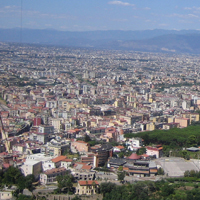Scenario Analysis. Toward a Change in the Soil Consumption Paradigm
Abstract
The processes of urbanization affecting the modern world have seen the explosion of the city and the transformation of compact and well defined structures in agglomerations with a seamlessly expansion. This has sparked a number of social and economic consequences that have impacted on the city, on the urbanized areas, and on the surroundings. The usage of the term “sprawl” to define the process of expansion of the human agglomerations dates back to eighty years ago, about, and from that period countless researches were done on the argument, also if it is open the question about the future trends of the city; if it is clear that the expansive model is still winning, it is equally necessary to identify new models that can better interpret the needs for a new attention to the territory and its environment. For this purpose the paper explores the feasible use of the scenario analysis as tool for defining the potential evolutionary paths of the city. Particular attention is placed on the construction of de-urbanization’s scenarios, namely the set of reorganization’s hypotheses of urban structures focused on the compaction of their physical size and on the maximizing of the number of residents and users. The paper seeks to deepen the possible trajectories of de-urbanization and of urban and territorial reorganization stretched to reverse the diffusion and expansive processes at the metropolitan level. The paper initially defines the characters of the processes of urbanization, also with reference to some research’s models. The second part investigates the use of scenarios for the construction of evolutionary trends. The third, finally, examines the trends comparing the processes of urban growth and of de-urbanization.
Downloads
References
Antrop M, 2004, “Landscape change and the urbanization process in Europe”, Landscape and Urban Planning, 67 9-26.
Batty M, Barros J, Sinesio-Alves, J, 2005, “The Dynamics of Cities”, in Le relazioni tra conoscenza ed innovazione nello sviluppo dei territori Eds. A Bruzzo, S Occelli (FrancoAngeli, Milano), pp. 371-385.
Damodaran A, s.d., Probabilistic Approaches: Scenario Analysis, Decision Trees and Simulations, Teaching paper available on the Internet at: http://people.stern.nyu.edu/adamodar/pdfiles/papers/probabilistic.pdf (accessed Nov. 15, 2011).
European Commission, 2011, COM(2011) 571 Roadmap to a Resource Efficient Europe.
Huss W R, 1988, “A move toward scenario analysis”, International Journal of Forecasting, 4(3) 377-388.
Le Corbusier, 1967 (1933), The Radiant City: Elements of a Doctrine of Urbanism to Be Used as the Basis of Our Machine-Age Civilization (Orion Books, New York).
Mazzeo G, 2011, “Trasformazioni urbane nelle capitali post-unitarie: Torino, Firenze, Roma”, TeMA – Journal of Land Use, Mobility and Environment, 4(1) 15-28.
Moccia F D, 2010, “Densificazione delle aree sottoutilizzate”, Paper for the XIII Conferenza Società Italiana degli Urbanisti Città e crisi globale: clima, sviluppo e convivenza, Roma, February 25-27, available on the Internet at: siu.dipsu.it (accessed Jan. 3, 2012).
Mumford L, 1945, “The metropolitan milieu”, in City development L. Mumford (Harcourt, Brace and Company, New York).
Murray J, King D, 2012, “Oil’s tipping point has passed” Nature, 481 433-435.
Nechyba T J, Walsh R P, 2004, “Urban Sprawl” The Journal of Economic Perspective, 18(4) 177-200.
Piorr A, Ravets J, Tosics I, 2011, Peri-urbanization in Europe. Towards European Policies to Sustain Urban-Rural Futures. Syntesis Report (PLUREL Consortium, Berlin).
Postma T J B M, Liebl F, 2005, “How to improve scenario analysis as a strategic management tool?” Technological Forecasting & Social Change, 72 161-173.
Rittel H, Webber M, 1973, “Dilemmas in a general theory of planning” Policy Science 4 155–69.
Sitte C, 1889, De Städtebau nach Seinen Künstlerishen Grundsätzen (Verlag, Wien).
Van der Berg L, Drewett R, Klaassens L H, Rossi A , Vijverberg, C H T, 1982, Urban Europe. A Study of Growth and Decline - Vol. 1 (Pergamon Press, Oxford).
Viollet-le-Duc E, 1867-1872, Entretiens sur l’architecture (Morel, Paris).
Wilkinson A, Eidinow E, 2008, “Evolving practices in environmental scenarios: a new scenario typology Environmental Research Letters 3 1-11.

Copyright (c) 2014 Tema. Journal of Land Use, Mobility and Environment

This work is licensed under a Creative Commons Attribution 4.0 International License.
Authors who publish in this journal agree to the following:
1. Authors retain the rights to their work and give in to the journal the right of first publication of the work simultaneously licensed under a Creative Commons License - Attribution that allows others to share the work indicating the authorship and the initial publication in this journal.
2. Authors can adhere to other agreements of non-exclusive license for the distribution of the published version of the work (ex. To deposit it in an institutional repository or to publish it in a monography), provided to indicate that the document was first published in this journal.
3. Authors can distribute their work online (ex. In institutional repositories or in their website) prior to and during the submission process, as it can lead to productive exchanges and it can increase the quotations of the published work (See The Effect of Open Access)
